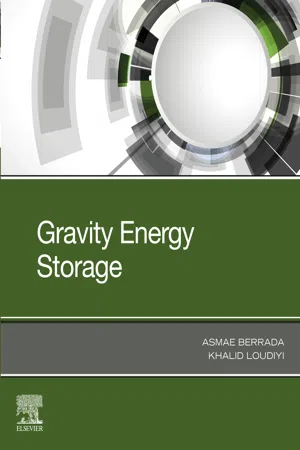
- 186 pages
- English
- ePUB (mobile friendly)
- Available on iOS & Android
Gravity Energy Storage
About this book
Gravity Energy Storage provides a comprehensive analysis of a novel energy storage system that is based on the working principle of well-established, pumped hydro energy storage, but that also recognizes the differences and benefits of the new gravity system. This book provides coverage of the development, feasibility, design, performance, operation, and economics associated with the implementation of such storage technology. In addition, a number of modeling approaches are proposed as a solution to various difficulties, such as proper sizing, application, value and optimal design of the system.The book includes both technical and economic aspects to guide the realization of this storage system in the right direction. Finally, political considerations and barriers are addressed to complement this work.- Discusses the feasibility of gravity energy storage technology- Analyzes the storage system by modelling various system components- Uniquely discusses the characteristics of this technology, giving consideration to its use as an attractive solution to the integration of large-scale, intermittent renewable energy
Frequently asked questions
- Essential is ideal for learners and professionals who enjoy exploring a wide range of subjects. Access the Essential Library with 800,000+ trusted titles and best-sellers across business, personal growth, and the humanities. Includes unlimited reading time and Standard Read Aloud voice.
- Complete: Perfect for advanced learners and researchers needing full, unrestricted access. Unlock 1.4M+ books across hundreds of subjects, including academic and specialized titles. The Complete Plan also includes advanced features like Premium Read Aloud and Research Assistant.
Please note we cannot support devices running on iOS 13 and Android 7 or earlier. Learn more about using the app.
Information
Energy Storage
Abstract
Keywords
Introduction
Table of contents
- Cover image
- Title page
- Table of Contents
- Copyright
- Dedication
- Preface
- Acknowledgments
- About the Authors
- Chapter 1. Energy Storage
- Chapter 2. Technical Design of Gravity Energy Storage
- Chapter 3. Economic Evaluation and Risk Analysis of Gravity Energy Storage
- Chapter 4. Gravity Energy Storage Applications
- Chapter 5. System Performance and Testing
- Chapter 6. Energy Storage Challenges
- Chapter 7. Conclusion
- Index